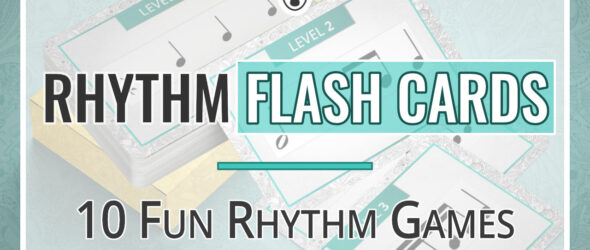Learning how to play the correct rhythm can be a challenge for any musician. Luckily, Rhythm Cards can help anyone to learn various rhythms in a fun and easy way!
Check out the free set of Rhythm Cards or upgrade it right away to the full set, and play 10 fun games to bring your rhythm reading to the next level.
Print Your Free Rhythm Flash Cards (PDF)
Before you start playing the games, you can download your free printable Rhythm Cards below:
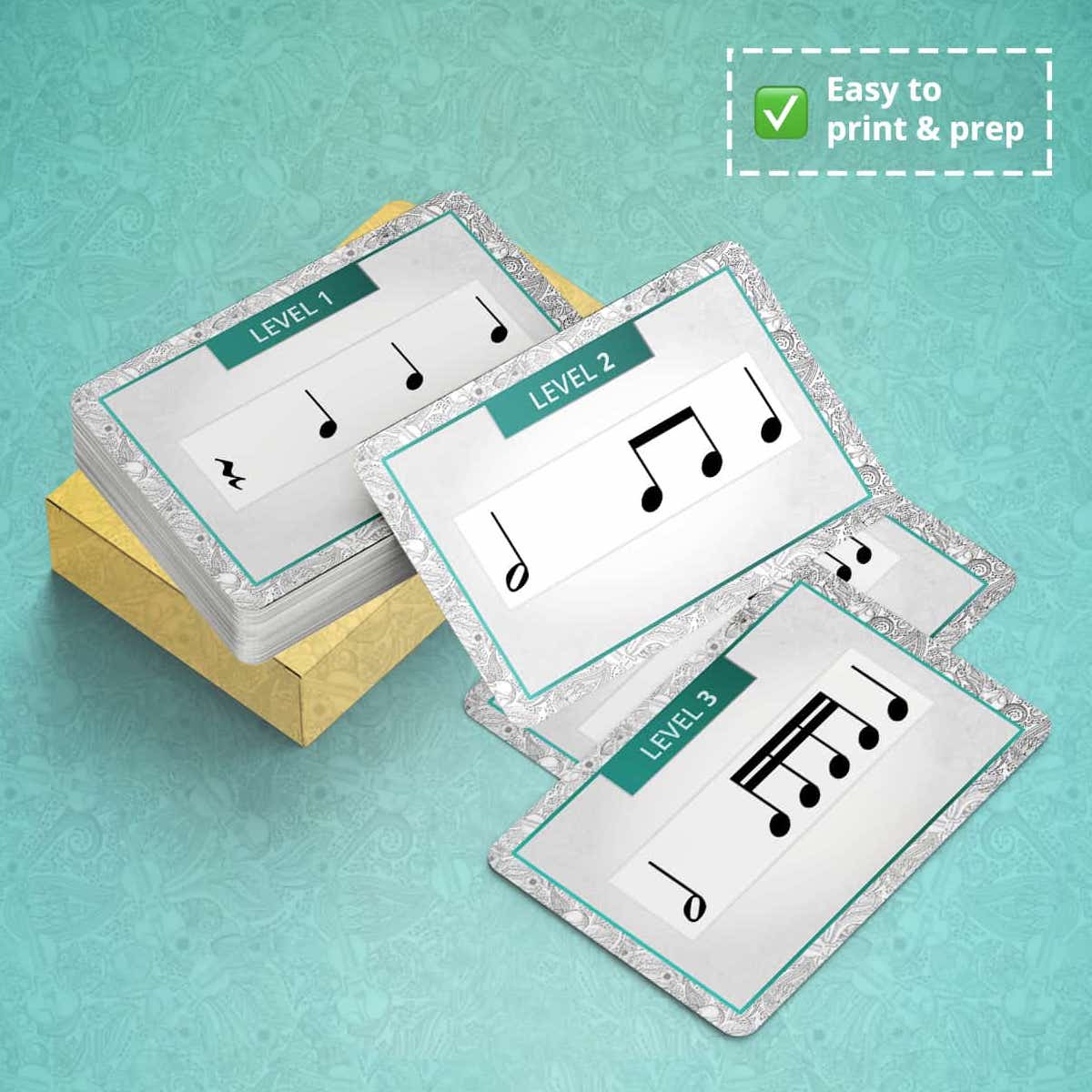
Download Your Free Rhythm Cards
Levels 1 – 4
In your download, you will find 50 free rhythm flashcards. Print the flashcards and cut the cards along the lines with scissors or with a knife (a mat and a metal ruler will be helpful in this case).
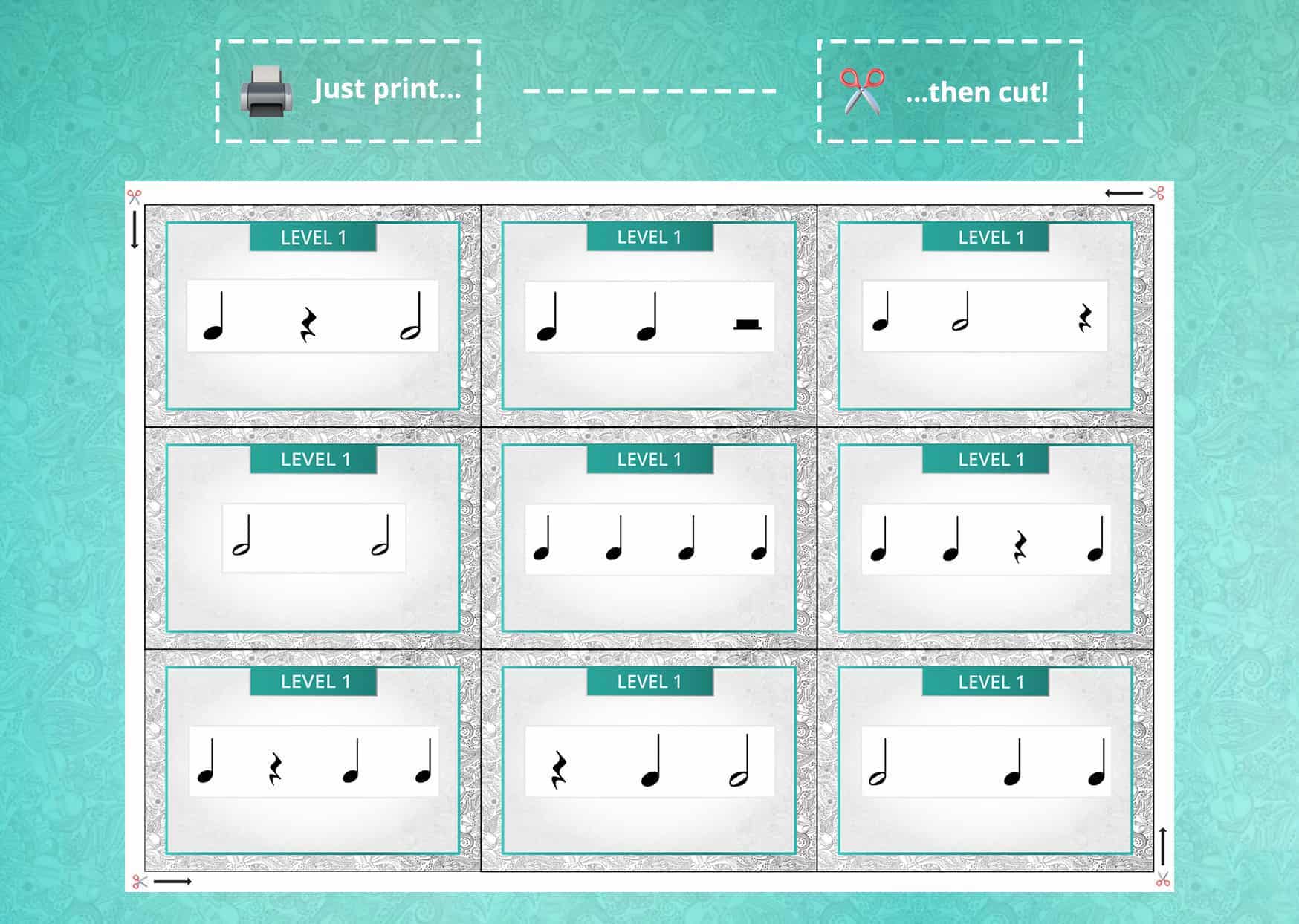
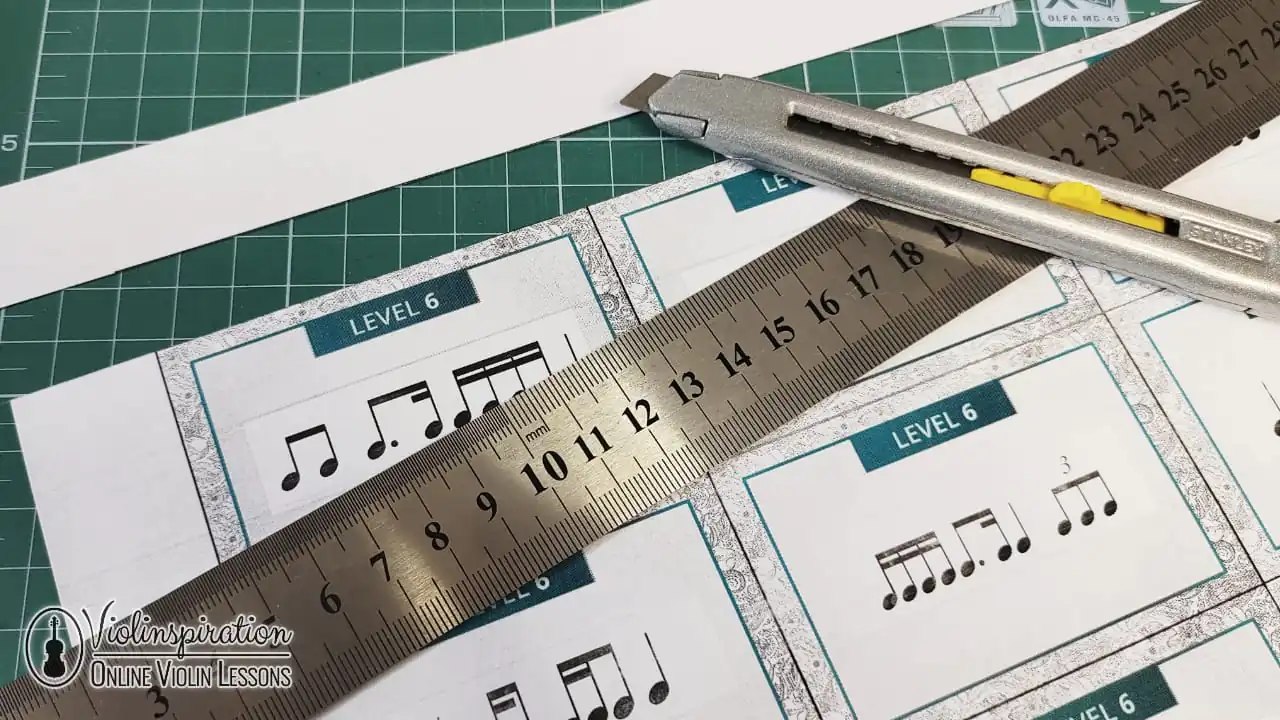
As you can see, the cards are organized levels. The free Rhythm Cards contain the first 4 levels of the full set of Rhythm Cards. These levels are fundamental to master for any music student.
- In level 1, you will learn to clap with half notes and quarter notes.
- In level 2, you will learn dotted half notes and eighth notes.
- In level 3, you will learn to clap sixteenth notes.
- In level 4, you will learn to clap a combination of the sixteenth and eighth notes.
If you would like to improve your rhythm reading beyond the most common rhythms, you can upgrade your set of Rhythm Cards.

Check out the full package of Rhythm Cards by clicking the button above. In this deck, you will find 6 more levels with more than 100 cards. These cards contain all the difficult rhythms. For example, sextuplets and challenging rhythm combinations with dotted sixteenth and eight notes.
When you play with the cards, you can think of each card as one bar in a piece. Cards in levels 1 to 8 have the simple time signature – 4/4, while in levels 9 and 10, the rhythm notations are designed for a compound time signature – 6/8.
If you master all 10 levels, you can truly call yourself a rhythm expert!
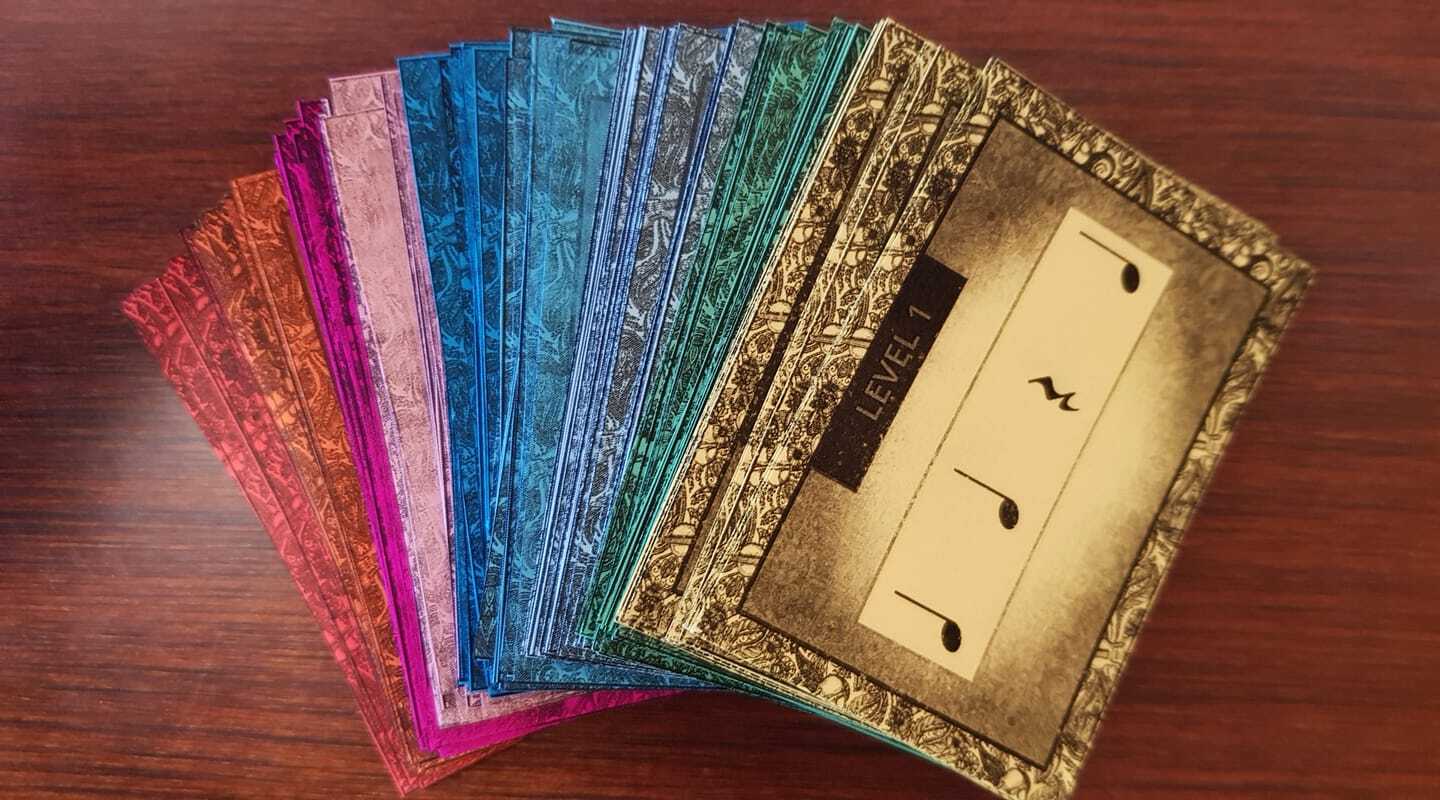
Now, when you have downloaded and prepared your Rhythm Cards, you are probably thinking about what fun games you could play. That’s why I compiled for you a list of 10 fun rhythm games!
Rhythm Card Games for 1 Player
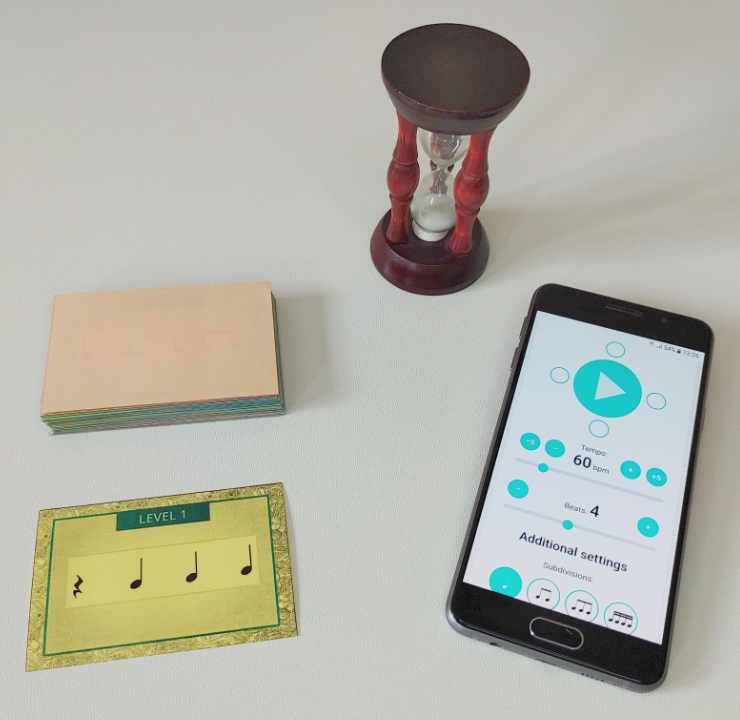
1. The Rhythm Collector
The Rhythm Collector is a game for one player to play with the full Rhythm Card deck. This is the most simple, but maybe also the most important rhythm card game you can play.
Game rules
The goal of the game is to collect as many Rhythm Cards as possible within 5 minutes.
Set up
To start playing, place all cards in front of you on the table to form the stock.
Take the top card off the stock, flip it face-up, and place it next to the stock to form the discard pile.
Put a metronome on the table or use a phone/tablet/computer to display my free online metronome.
Also, use a timer on your phone, take a kitchen timer, or use an hourglass if you have one.
How to play
To play this game, set the metronome to 60 BPM and set the timer to 5 minutes.
Choose the first card from the stockpile and clap the rhythm on the beat of the metronome.
If you managed to clap the rhythm, keep the card. If you weren’t able to clap the rhythm in tempo, practice the rhythm until you can clap it and discard the card.
If at any point in the game the stockpile runs out, the discard pile is shuffled to form a new stockpile.
Continue to collect as many Rhythm Cards as possible within 5 minutes.
When finishing the game, count the number of cards you have clapped correctly.
You can notate your best scores on a piece of paper. Try to improve your best score each time you play the game!
Variations
You can adjust the speed of the metronome and challenge yourself to clap more rhythms within 5 minutes.
You can also play the rhythms on an open string on your violin (or on another instrument).
You can vary the length of the timer to change how long the game lasts.
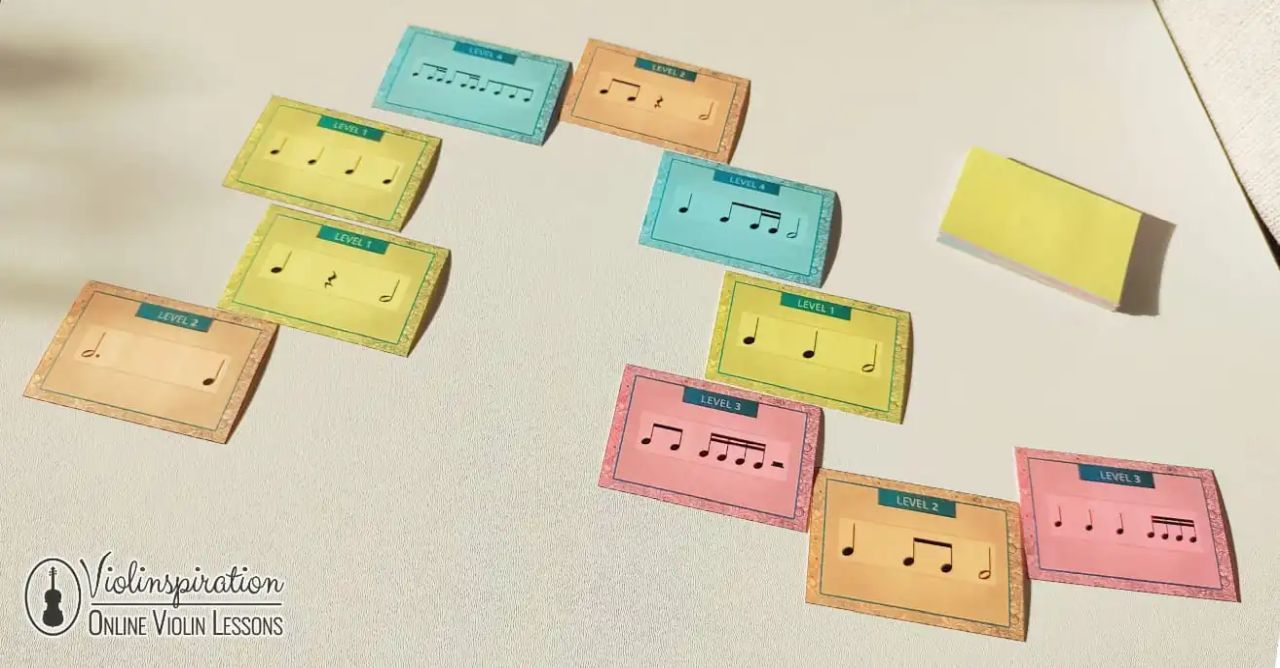
2. The Rhythm Chain
Game rules
The goal of the game is to clap in tempo as many consecutive Rhythm Cards as possible. You are not allowed to take a break between cards.
One point is scored for each rhythm card that is clapped correctly.
If you clap all 10 cards correctly, you get awarded a bonus of 10 extra points. That means that if you clap all 10 cards correctly, you receive 20 points in total.
If all cards of the deck are finished, the game is finished.
Set up
Play this game with at least 50 Rhythm Cards (see “Variation” if you have fewer Rhythm Cards).
Place 10 Rhythm Cards in a row on the table. All other Rhythm Cards are on the side in a stock.
How to play
To play this game, consecutively clap all rhythms of the cards in the order they are placed.
For each rhythm that you clap correctly, you will get one point. If you clap all 10 rhythms correctly, you will get 10 bonus points (a total of 20 points).
After each turn, remove 5 cards and put them on the discard pile. Replace them with 5 new cards from the stock.
Shuffle the 10 cards and place them back on the table to start your next turn.
Your goal is to collect as many points as possible before all cards of the pile are discarded.
Game play example
Suppose a player has clapped 5 consecutive rhythms correctly. On the sixth rhythm, the player makes a mistake.
That means the player receives 5 points.
In the second turn, the player claps all 10 cards correctly.
That means the player receives 10 points, plus 10 bonus points. The player has earned 20 points in this turn, which makes 25 points in total.
Variations
You can easily play this game with 2 players. The person who has more points by the end of the game wins.
You can play this game with a metronome to make it easier to hold the beat. I recommend a metronome set at 60 BPM.
If you play this game with more than 50 Rhythm Cards, you may want to exchange more than 5 Rhythm Cards each turn. In that way, you can reduce your playing time.
If you play this game with less than 50 Rhythm Cards, you may want to exchange less than 5 Rhythm Cards to extend your playing time.
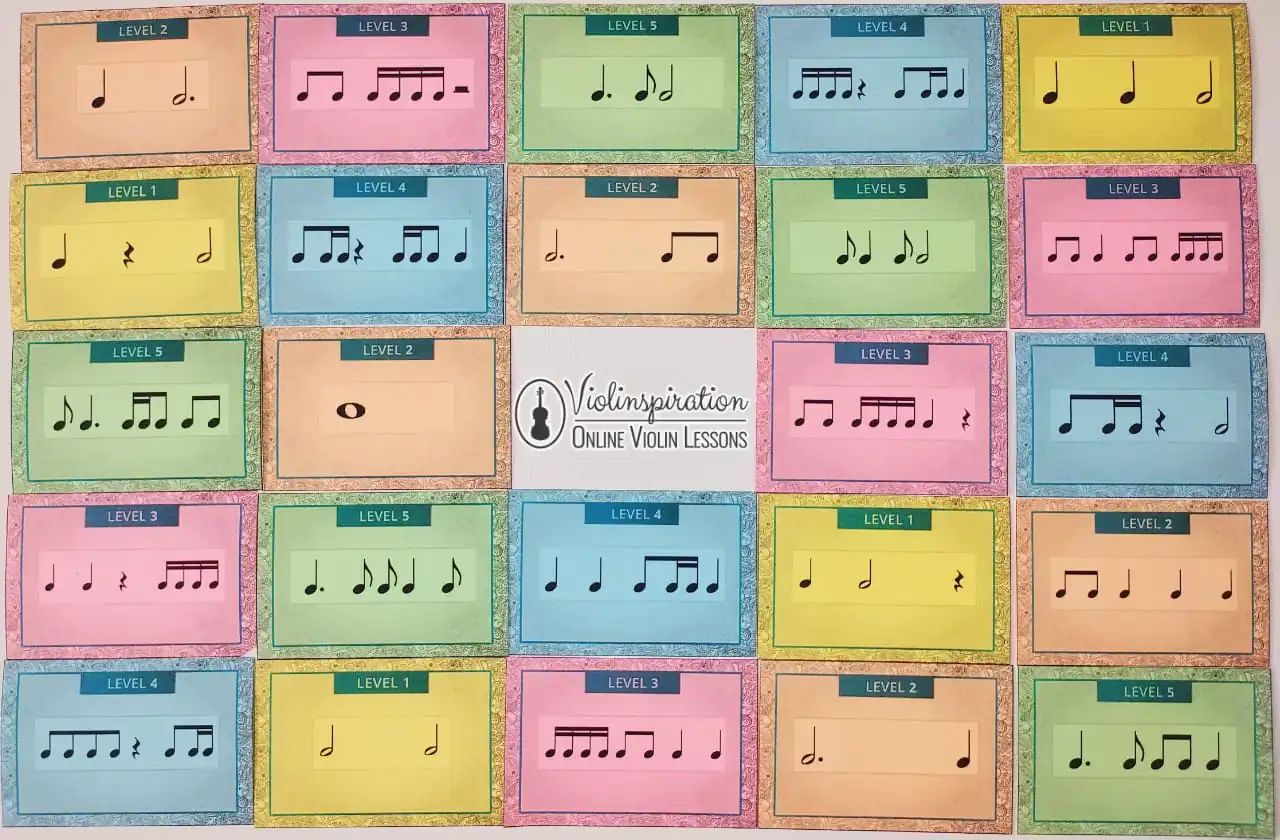
3. Try Rhythm Bingo!
Rules
Remove the rhythm card when played correctly. Remove five Rhythm Cards in a row to win at Bingo!
Setup
Build a Bingo board with your Rhythm Cards by placing 5 cards across and 5 cards down.
Fill in your square with the remaining cards.
Leave the center square blank.
How to play
Play the rhythm, remove the card.
Play a complete row and remove all 5 cards, BINGO!
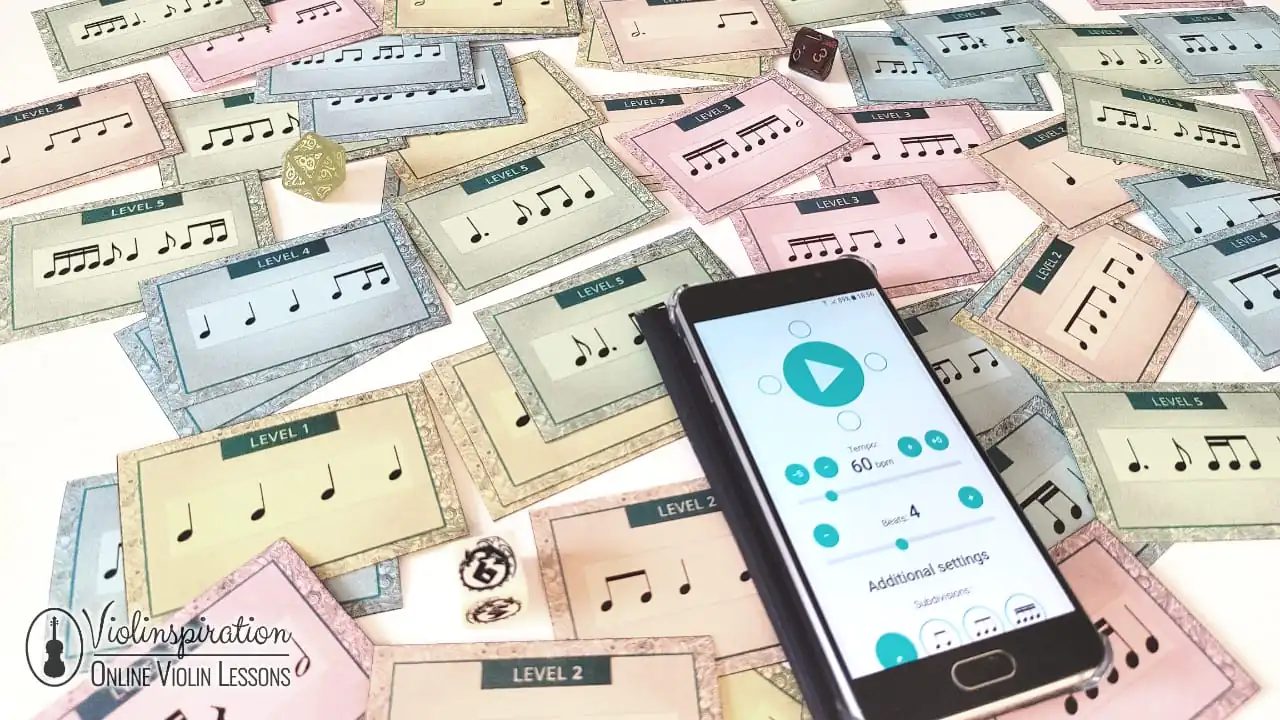
4. Roll the Dice, Play a Rhythm
Game rules
Play a musical phrase given to you by the luck of the dice. Play it correctly before you can roll again.
Setup
Use six-sided dice. Assign a Rhythm Card to each number.
How to play
Roll the dice. Play or clap the musical phrase.
Variation
For an advanced version, use a metronome and increase the BPM by 2 before you can roll again.
Rhythm Card Games for 2 or More Players
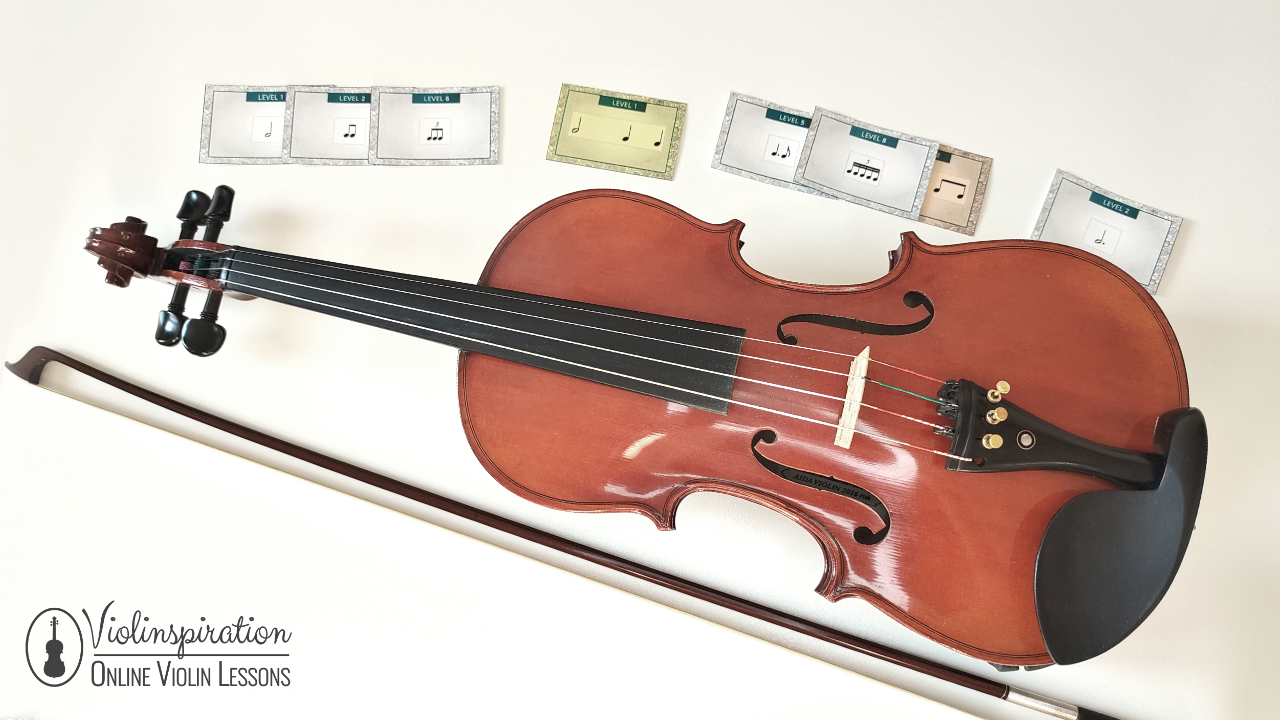
5. Name That Tune
Game rules
Use your Rhythm Cards to name the pattern played by your fellow violinist.
Setup
Tune your violin and have your Rhythm Cards ready.
How to play
One person plays the first few bars of a familiar piece. The second person has to lay out the rhythm pattern using the Rhythm Cards.
💡 You may need to use various Rhythm Cards to form the required musical phrase. Put the cards in a way that only the needed notes are visible (see the picture above).
Variation
One person lays out the Rhythm Cards of a familiar piece. The second person has to name the piece from reading the rhythm pattern cards. Extra points if they can play it!
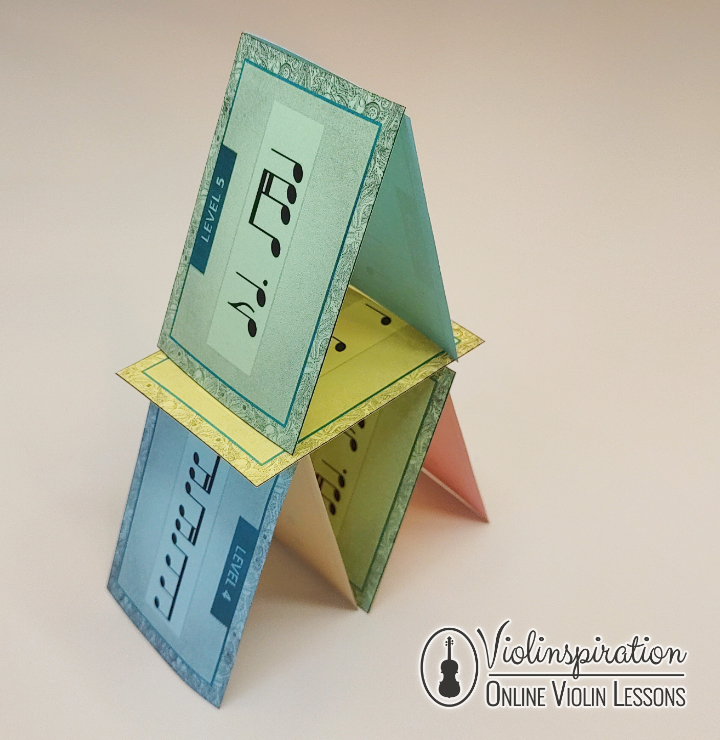
6. Rhythm Card Tower
Have you ever built a card tower using a deck of playing cards? Let’s build one with two players using the Rhythm Cards!
Be careful to have a steady hand when placing your card. You don’t want to lose because you knocked down the tower.
💡 It will be easier to play this game if you have printed your Rhythm Cards on photo paper or have them laminated.
Game rules
Create a tower by placing Rhythm Cards next to and on top of each.
Don’t destroy the tower or you will have to play all of the Rhythm Cards it took to build the tower!
Setup
Each player shuffles their Rhythm Cards.
Using a table or hard surface, begin building the card tower by leaning one card from each player next to each so the corners touch. It may look like the Greek Lambda symbol: Λ. Continue to place cards next to and on top of each other to build your tower.
Use the image above or be creative and design your own card tower.
How to play
Drawing from the top of their card pile, the first person plays their rhythm pattern.
Do they play it correctly? They lean their played card and an additional card next to the two cards so they connect and add to the tower.
Play it incorrectly? You put it on a discard pile.
The next player draws from their pile and the game continues accordingly.
Try not to destroy the tower when placing a card. If the card tower falls, that player must try to play all of the rhythm patterns of the cards in the tower consecutively. If they can do this without a mistake, they pass the cards to the other player who adds them to their discarded pile. If they make a mistake while playing through all the cards, they must stop and add the cards to their discard pile.
Continue the game by using 2 new, unplayed cards to build a new tower.
The person with the least amount of playing cards in their discard pile at the end wins!
Try to build a high tower by playing all rhythm patterns correctly and keeping the tower intact!
7. Round Robin
Game rules
Play the rhythm card pattern correctly on your violin. You lose if you mess up.
Setup
Tune your violin. Shuffle Rhythm Cards.
How to play
Player one picks and plays a rhythm card pattern.
Player two picks a rhythm card pattern and plays cards one and two.
Player one picks again and plays cards one, two, and three.
Player two picks a rhythm card again and plays cards one, two, three, and four.
Keep adding to this pattern until someone plays a phrase incorrectly.
The next person has to play the phrase correctly to win!
Rhythm Card Games for 3 or More Players
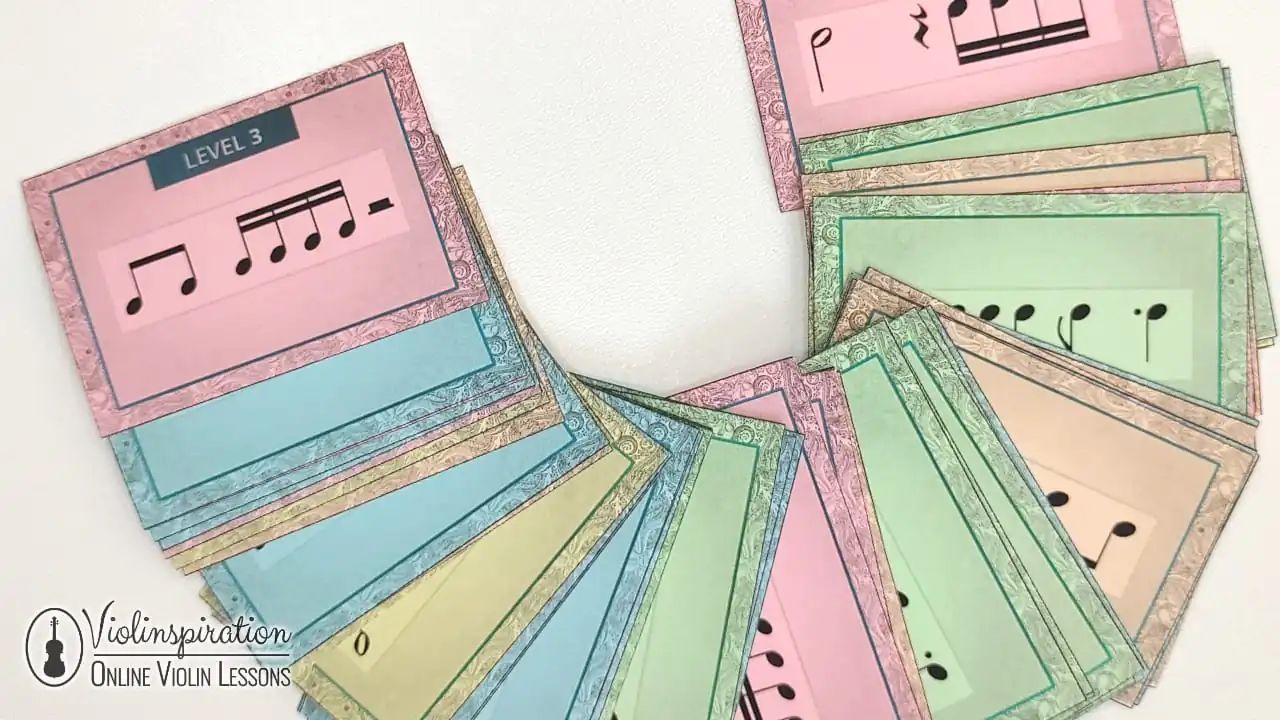
8. Rhythm Line-Up
Game rules
You are timed in how long it takes you to figure out a musical phrase played by fellow players. The person with the shortest time wins.
Setup
One player leaves the room. The other players each pick a rhythm card pattern to play. They try to memorize the pattern.
The cards are then placed in a pile.
The player comes back into the room.
How to play
The players line up and play their rhythm card patterns one after another continuously without a break in between them.
The person who entered the room, must then go through the rhythm card pile and line up the cards the way they were played.
The player is timed for how long it takes them to find the correct musical phrase.
The process repeats itself rotating players.
The person with the shortest amount of time wins!
Variations
To vary the difficulty level of this game, you can use more cards in the pile to make the game more difficult, or fewer cards in the pile to make the game easier.
9. Concertmaster
Game rules
Play a musical phrase correctly with the metronome. If the concertmaster hears you play incorrectly, he will tap you out.
Setup
One person (concertmaster) creates a musical phrase by placing several Rhythm Cards in a row.
They place the Rhythm Cards where everyone else can read them.
They set the metronome to 60 BPM.
How to play
Everyone tries to play the musical phrase with the exact note length and using the correct rhythm pattern.
The concertmaster listens to see who is playing correctly. You will get tapped on the shoulder by the concertmaster if he hears you play incorrectly.
If you get tapped, you are out.
The person left standing at the end wins!
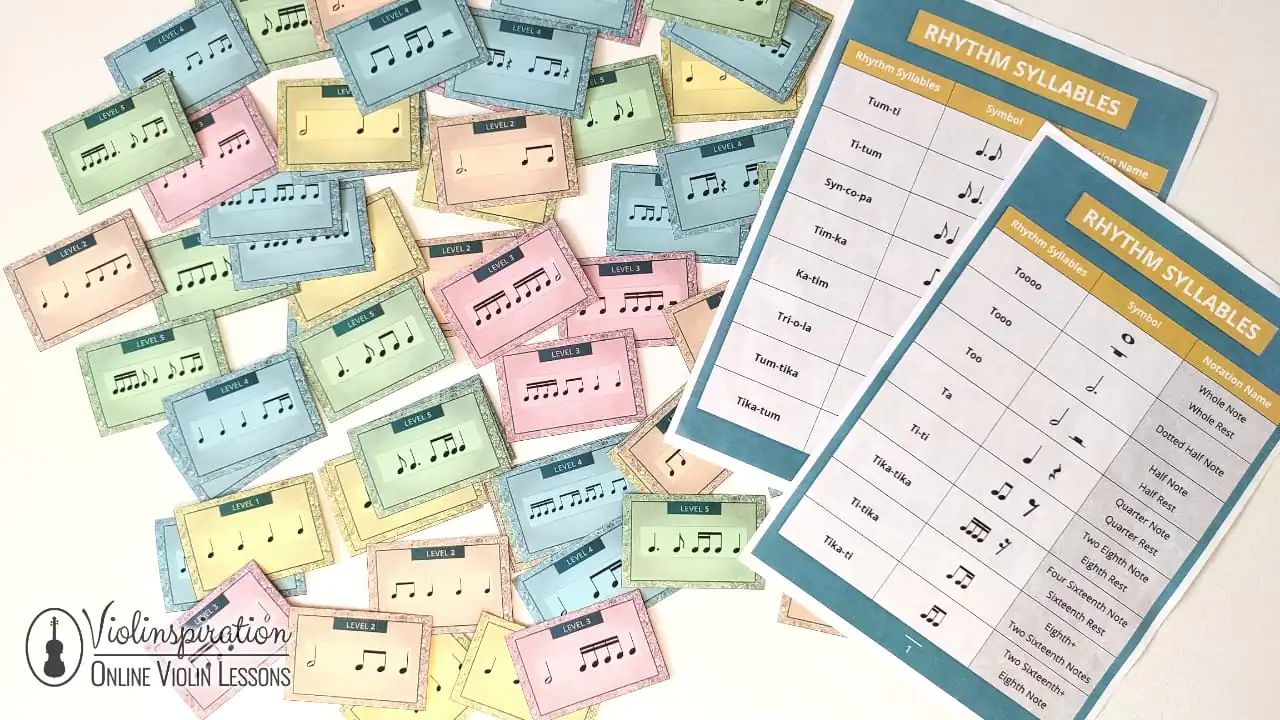
10. Kodály Charades
Game rules
Find Rhythm Cards that match the Kodály speech pattern names spoken, clapped, or tapped by your teammate. You have two minutes until your time is up.
Setup
Divide your group into two equal teams. Have Rhythm Cards ready as well as a chart with the Kodály rhythm pattern names to match.
👉 If you’re a member of Julia’s Violin Academy, download the list of Kodály syllables over here.
Have a timer, a watch, or a kitchen timer ready.
Decide how many rounds you would like to play.
How to play
Team One picks a player. That player picks Kodály rhythm pattern names or series of patterns forming a musical phrase. For example, Tika Tika Ta Tika Tika Too Ti Ti Too.
Set a timer for two minutes.
The player can choose to either clap, stomp or speak the rhythm.
The rest of the player one’s teammates have two minutes to lay out the Rhythm Cards that fit the rhythm phrase being described.
They get 1 point if they get it right before the timer goes off. Zero points if they cannot.
After the timer goes off, it is team two’s turn to play.
Team Two plays the game the same way.
The team with the most points at the end of the rounds wins!
I hope you enjoy the rhythm games. Have fun practicing all the rhythms and make sure to get your deck of Rhythm Cards below if you haven’t yet!
And, if you enjoy playing games, check out also D.I.Y. Violin Mystery Escape Game (Printable PDF & MP3).

Download Your Free Rhythm Cards
Levels 1 – 4

